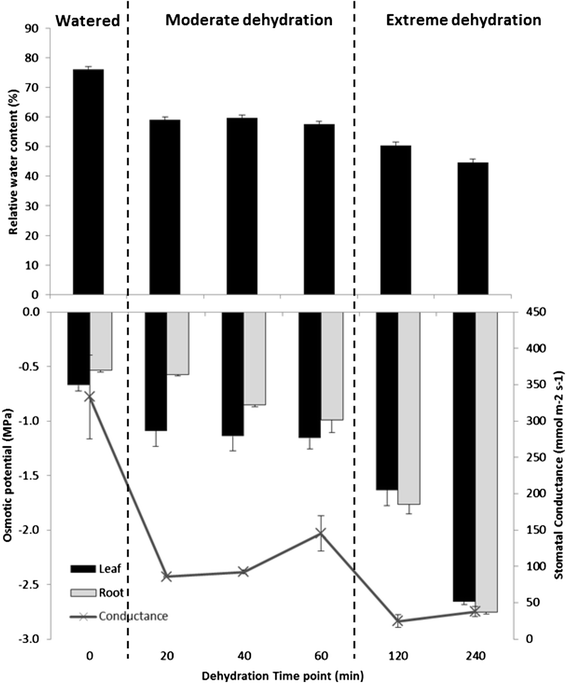Escape from the Tray of the Damned: a seedling drought story
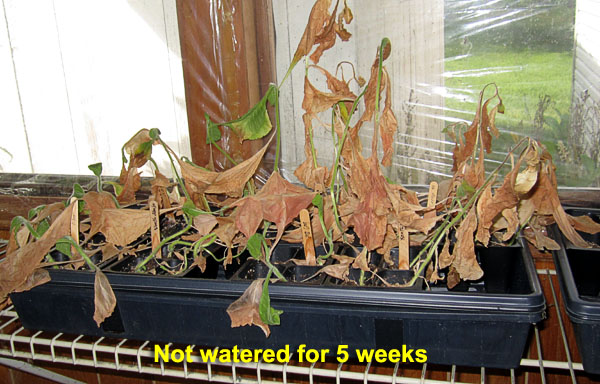
5 July 2023
Newly germinated seedlings were transferred to cell inserts in 1020 trays in early March 2023. As transplants were put into their respective garden beds, my intentional extras were eventually consolidated into this one remaining 1020 tray.
Purely for the sake of science and the betterment of mankind, I ignored this tray (i.e. never bothered to watered it) from some date in late May until 5 July. It contained my spare transplants, in case I needed to replace any transplant mortality in the garden beds. But by the final week of May, I realized that my transplant mortality for the season was a surprising zero. No need for replacements. No need to continue watering the tray of spares. The 1020 tray remained on a wire shelf in my enclosed back porch, with at least ½ day of direct sunlight through the glass.
Varieties in the tray (There were no Tofta extras.):
Does the scattered greenery indicate that they could actually recover with the addition of water now? If it does, then that would certainly say something about the drought tolerance of Nicotiana tabacum. (As a bonus, by just adding water, I could postpone having to carry the contents of the tray to its destined grave beyond the back fence.) It's citizen science!
I added 1½ quarts of water to the tray in mid morning. Within 20 minutes, the tray was dry. I added another 1½ quarts. I could almost hear epigenetic whispering, if I held my ear really close.
After 24 hours:
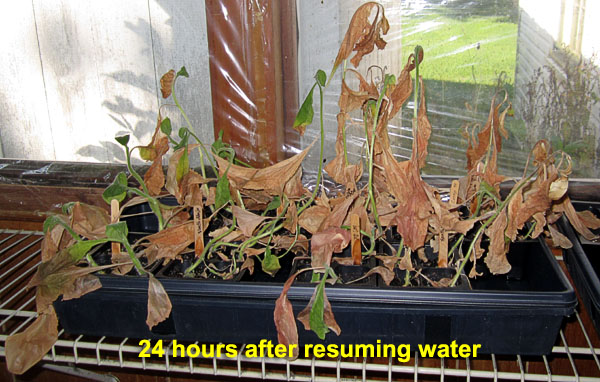
6 July 2023
After 48 hours:
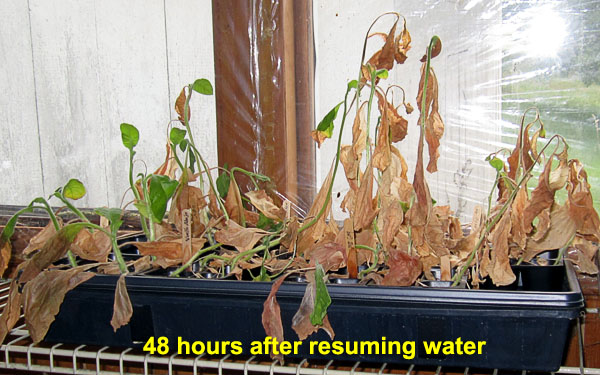
7 July 2023
I added water to the upper tray (with holes) as needed, to keep the soil from drying out.
At the end of a week:
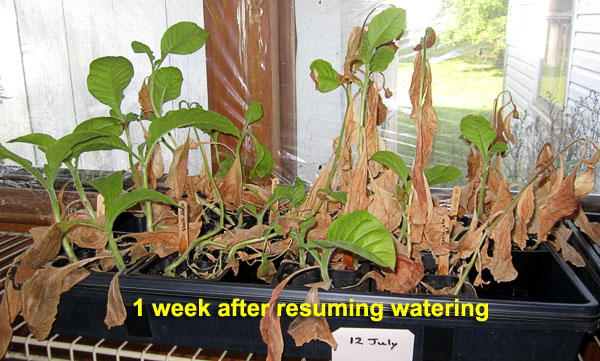
12 July 2023
Counts of Surviving Varieties: [count survived / initial count]
So long as the apical meristem (growth tip) of the plant is still alive, OR if there is at least one node on the stalk still alive (at a leaf axil), the plant will resume growth upon watering. Some of those that didn't make it might still be able to send up a sucker from the root system, though I did not observe that. A question not addressed by this experiment is whether or not there is a specific window of age (post germination) during which a tobacco seedling can survive such an ordeal. The seedlings in the Tray of the Damned were all about 3 months post germination at the start of the drought, and were over 4 months post germination in the final image.
I'm not suggesting that you ever do this with your plants, but the exercise indicates just how drought tolerant tobacco can be, once it has developed a root system and a sturdy seedling stalk.
Bob's Aphorism: Overwatering kills; underwatering builds character.
I could, if I wished, transfer survivors into 3-inch pots, and maintain them as runted plants through the winter—topping them above the lowest leaf each time they grew too tall. Then in the spring, if such a plant is finally transplanted to the garden with at least one leaf node above the ground, it would grow into a relatively normal, primary season plant, with a reasonably normal primary crop of nice leaf. [I demonstrated that a few years ago with small, potted tobacco plants of several varieties, that I did not transplant to the garden until their third season of growth.]
Bob

5 July 2023
Newly germinated seedlings were transferred to cell inserts in 1020 trays in early March 2023. As transplants were put into their respective garden beds, my intentional extras were eventually consolidated into this one remaining 1020 tray.
Purely for the sake of science and the betterment of mankind, I ignored this tray (i.e. never bothered to watered it) from some date in late May until 5 July. It contained my spare transplants, in case I needed to replace any transplant mortality in the garden beds. But by the final week of May, I realized that my transplant mortality for the season was a surprising zero. No need for replacements. No need to continue watering the tray of spares. The 1020 tray remained on a wire shelf in my enclosed back porch, with at least ½ day of direct sunlight through the glass.
Varieties in the tray (There were no Tofta extras.):
- NB-11 burley
- Little Yellow
- Xanthi-Yaka 18a
- Corojo 99
- Olor
- Vuelta Abajo
- Maryland 609
Does the scattered greenery indicate that they could actually recover with the addition of water now? If it does, then that would certainly say something about the drought tolerance of Nicotiana tabacum. (As a bonus, by just adding water, I could postpone having to carry the contents of the tray to its destined grave beyond the back fence.) It's citizen science!
I added 1½ quarts of water to the tray in mid morning. Within 20 minutes, the tray was dry. I added another 1½ quarts. I could almost hear epigenetic whispering, if I held my ear really close.
After 24 hours:

6 July 2023
After 48 hours:

7 July 2023
I added water to the upper tray (with holes) as needed, to keep the soil from drying out.
At the end of a week:

12 July 2023
Counts of Surviving Varieties: [count survived / initial count]
- NB-11 burley: [4 / 4]
- Little Yellow: [2 / 4]
- Xanthi-Yaka 18a: [6 / 12]
- Corojo 99: [0 / 4]
- Olor: [4 / 4]
- Vuelta Abajo: [3 / 4]
- Maryland 609: [3 / 3]
So long as the apical meristem (growth tip) of the plant is still alive, OR if there is at least one node on the stalk still alive (at a leaf axil), the plant will resume growth upon watering. Some of those that didn't make it might still be able to send up a sucker from the root system, though I did not observe that. A question not addressed by this experiment is whether or not there is a specific window of age (post germination) during which a tobacco seedling can survive such an ordeal. The seedlings in the Tray of the Damned were all about 3 months post germination at the start of the drought, and were over 4 months post germination in the final image.
I'm not suggesting that you ever do this with your plants, but the exercise indicates just how drought tolerant tobacco can be, once it has developed a root system and a sturdy seedling stalk.
Bob's Aphorism: Overwatering kills; underwatering builds character.
I could, if I wished, transfer survivors into 3-inch pots, and maintain them as runted plants through the winter—topping them above the lowest leaf each time they grew too tall. Then in the spring, if such a plant is finally transplanted to the garden with at least one leaf node above the ground, it would grow into a relatively normal, primary season plant, with a reasonably normal primary crop of nice leaf. [I demonstrated that a few years ago with small, potted tobacco plants of several varieties, that I did not transplant to the garden until their third season of growth.]
Bob


